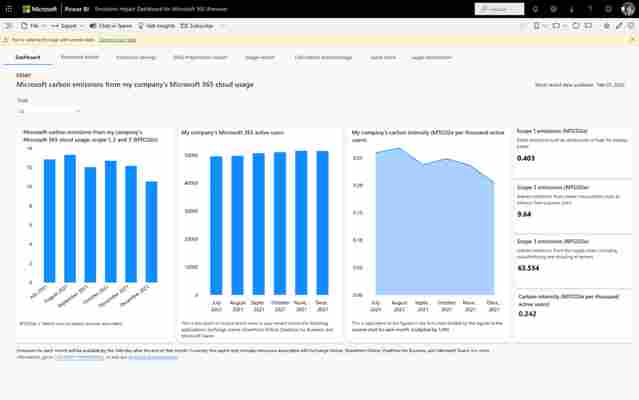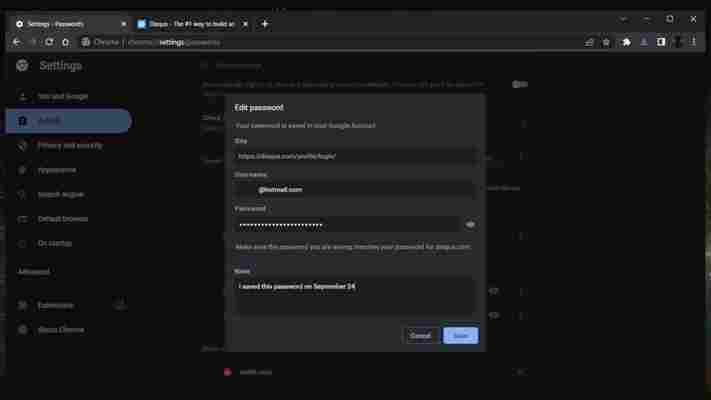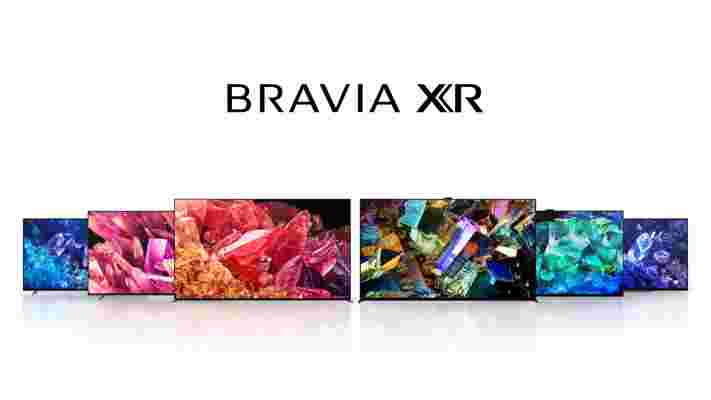Microsoft has been making strides in helping companies track their emissions in recent months, an especially useful goal given the ubiquity of its tools in almost every large organization.
In October 2022, Microsoft introduced the Emissions Impact Dashboard for Azure, which does what it says on the tin: help Azure customers track emissions from their cloud usage, as part of its Power BI tools.
Now, the company is taking things a step further by introducing the Emissions Impact Dashboard for Microsoft 365 , which performs a similar function but for a much wider audience.

Doing its part
"Organisations can use the Emissions Impact Dashboard for Microsoft 365 to quantify the greenhouse gas emissions associated with their organisation’s usage of Exchange Online, SharePoint, OneDrive for Business, and Microsoft Teams ," the company says, noting that more apps will be added over time.
"For more than a decade, Microsoft has invested in reducing its environmental impact while supporting the digital transformation of organizations around the world," Microsoft's Peter Bergen wrote in a blog post announcing the preview.
"We’re committed to becoming a carbon-negative, water-positive, and zero-waste company by 2030, and we intend to be transparent with our customers about our progress toward these goals."
The shift towards the cloud, especially during the pandemic, comes at a huge ecological and environmental cost; data centres are some of the most resource-hungry facilities in operation globally.
Google, Amazon, Meta, Apple, Microsoft, and others have all committed to "greening" their operations, usually by 2030, and we can only wait to see the progress and its impact.
In the meantime, Microsoft giving cloud users the ability to closely monitor their carbon emissions is a positive step forward.
Chrome is making it easier to remember passwords and sensitive information
Google is developing a feature within the Chrome password manager that not only allows you to manually save passwords, but also add any useful notes that you would otherwise need to save elsewhere.
This was discovered by Reddit user u/Leopeva64-2 who notes that the feature is currently live within Chrome Canary version 101, the version of the Chrome browser used for beta testing new features before they get released onto the public build.
Manually adding passwords will give you better control over the saved information currently stored in the Google Chrome password manager , preventing you from having to visit every website and load your details in to be saved. This should also make it easier to clean up errors and situations where multiple passwords are saved with no other sign-in information, such as a username or email address.

It's unlikely you would need to save any password hints in the notes space, as you can simply unhide your password by selecting the eye icon next to it. But this could be useful for saving the answers to security questions, or even the date you signed up and last used the service, if you like to keep your open accounts to a minimum.
Concern was also raised on the same Reddit thread regarding encryption, though it's likely that anything saved within the notes field will be protected along with the actual passwords themselves.
Given most other password management services also encrypt all the information saved alongside the actual passwords, it would be unusual for Google to overlook this, but we won't know for sure until the feature is released to the general public.
As Neowin mentions in its own report, this is a feature that could also roll out to the Microsoft Edge web browser, given it's also based on Chromium. But it's early days for that, and we can't find anything similar to this feature currently being tested within the Microsoft Edge Insider channels.
It has a niche use, but its implementation could allow you to save small nuggets of useful information that are specific to each website you visit, such as payment information or the expiry date on your cards. Given this feature is currently being trialed, there's a chance it might never make it into the public version of the Chrome browser, which would be a real shame.
Analysis: What's the risk?
Any discussion about saving your passwords or private information online is going to cause some concern, but Chrome already has a lot of features that could put your mind at ease. For one, the Chrome password manager can prompt you if a password is weak or appeared in a data breach online.
To check your passwords, users just need to click on the key icon that appears under your profile. or you can manually type 'chrome://settings/passwords' in your address bar. This will also tell you if any of your passwords need to be updated because they've been compromised, though you'll still need to visit every site that the password/email address combination was used on to change them.
If anything, this outlines the importance of having individual passwords for every account you open – and with all of the websites and applications available to us, that can be daunting without a password manager.
Still, if you're worried about saving any private information to your browser, you'll either need to use a more dedicated service such as LastPass , or simply do things the old-fashioned way and either memorize or jot down your information on paper.
Sony announces the first QD-OLED TV of CES 2022
The next big innovation in TVs has officially arrived: Sony has announced the Sony Master Series A95K, the first-ever commercial QD-OLED TV, at CES 2022 .
The A95K is Sony’s only QD-OLED model coming to store shelves in 2022, but Sony says it will boast 200% the color saturation of a normal LED-LCD TV with wider viewing angles and better black levels.
Additionally, thanks to the Sony XR Cognitive Processor and a revolutionary new heat dissipation system, the A95K will be able to control contrast and maximize brightness better than before - giving it a huge advantage over traditional OLED screens.
In terms of ports, the A95K will have two full-spec HDMI 2.1 ports that can do 4K/120, VRR and ALLM, however one of those will also be eARC, meaning you might have to choose between adding a soundbar and keeping both the PS5 and Xbox Series X hooked up.
The Sony A95K will also come bundled with the new Bravia Cam, also announced at CES 2022. The additional piece of hardware will enable the A95K to track where you’re sitting to optimize audio output for that location, and allows you to use gesture control for playback.
For anyone with kids, the Bravia Cam allows you to set proximity alerts to tell little ones that they’re sitting too close to the screen, and an auto power saving feature that will turn off the screen if you walk out of the room for more than a few minutes.
There’s no pricing or firm release date for the Sony Master Series A95K, but it’s one of the most interesting new TVs shown off at CES and we’ll be following it closely.
Sony A95K QD-OLED photo gallery
Sony comes in strong with mini-LEDs, OLED TVs and new flagship LED-LCD screens
While the QD-OLED is the most interesting of Sony’s new 2022 TV catalog, it’s far from being the only new model in the lineup as Sony has also announced its first two mini-LED TVs alongside two new OLED and a new LED-LCD screen.
The most premium of the bunch are the new Z9K and X95K series that use mini-LED powered by the Backlight Master Drive technology we saw a few years ago in the Sony Z9D. That said, with the ability to control even smaller patches of mini-LEDs, Sony says that the Z9K and X95K have some of the best contrast control of any LED-LCD TV with higher peak luminance and less blooming.
Next down the line are the two new OLED screens, the A90K and A80K that use temperature distribution mapping and a new OLED panel for higher peak luminance. Both OLEDs have two HDMI 2.1 ports for 4K/120 like the A95K, and also share the same caveat that HDMI 3 is also eARC ready.
Last but not least is the new Sony X90K that will fill out the ranks as the most affordable mid-range model, likely similar in price to last year’s Sony X90J 4K LED-LCD TV.

Analysis: Is this the first and only QD-OLED we’ll see at CES?
Chances are good that Samsung could have a QD-OLED to show off at some point during the convention - potentially mere hours after this story goes live - but so far one hasn't appeared yet.
Last year, we reported that Samsung was purchasing a number of OLED panels from LG Display, and it seems like those will be used at some point for QD-OLED screens. That being said, Sony had a steady flow of OLED screens coming in from LG Display, which could have allowed the company to assemble a QD-OLED before other manufacturers.
We’ll keep an eye out for more QD-OLED screens (as well as mini-LEDs, MicroLEDs, ULEDs, QLEDs and regular ol’ OLEDs) as the show progresses, and we’ll be excited to get them in our own homes for testing later this year.